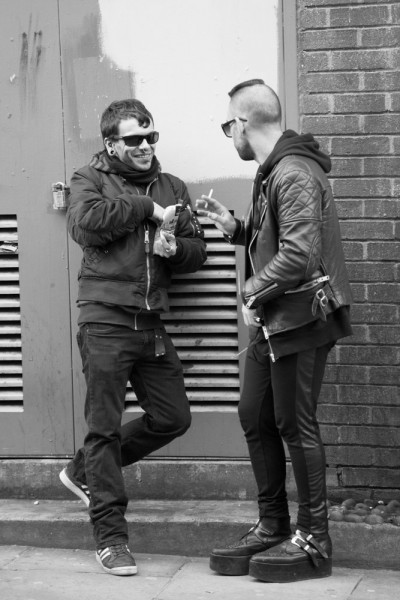This beauty was surrounded by admiring photographers on Sunday morning, and seemed to enjoy the attention.
Author Archives: qsf
Parental discretion advised
Eric Schmidt made a nice observation in a lecture tonight:
If you give your child an unusual name, they'll have a higher page ranking…
And as a responsible parent, you should certainly buy them their domain name as a christening present, I guess.
If you don't want to be too blatant, you could go half-way. Give them an available Twitter handle as a middle name, say, which would be OK at least until their wedding day.
“Wilt thou, Catherine sexygirl482 Jones, take this man to be your lawful wedded husband?”
Being Accessible
A friend of a friend has recently had what must be one of the most life-changing experiences anyone can go through. While in hospital for an operation, she had an apparently very rare but not unknown reaction to the anaesthetic, and found herself, suddenly and unexpectedly, completely blind.
She’s a very smart and resourceful woman, though, and is making serious efforts to discover what technology can do to help in her situation. And it’s an interesting challenge. I have some friends who have major visual impairments but can still use computers if, for example, the fonts are large and high-contrast, and they sit very close to the screen. And others have been blind from birth and have developed a whole range of skills to cope with it.
But for someone who has had to make the transition suddenly and unexpectedly in later life, and doesn’t have, for example, the ability to read braille, what can we geeks do to help? Well, there are the obvious things like screen-reading and voice-dictation software, which are useful if the underlying operating system and apps make it easy to navigate the rest of the system. On the Mac, at least — I can’t speak for Windows — there is quite pervasive VoiceOver integration at a fairly low level, so you can do most things, but learning it is tedious, and the challenge is then to navigate things efficiently using a wide range of key combinations on a keyboard which she’s still getting used to not being able to see.
But one thing we should be able to do these days is take advantage of the power of mobile devices more. A surprise to me is that the iPhone, with its slab-like non-tactile surface, turns out to be remarkably good, mostly due, again, to Apple having thought about this stuff pretty early on. But I hope we’ll start to see more apps that do, say, OCR-to-speech with minimal button presses, to allow people to read road signs and restaurant menus.
One of the best apps I’ve come across in my brief investigations is one that I think I’ll also use myself. It’s called Fleksy, and it’s a soft keyboard that uses predictive text technology to allow you to type just the approximate shape of the word as it would appear on a QWERTY layout and then swipe to the right – it will guess the word for you, and speak it. This is vital for blind people, of course, but also makes it much harder for any of us to get those accidental word-substitutions that can cause so much misunderstanding. (A favourite was when an attractive female friend of mine, on a work trip and feeling in need of a drink, once texted her male colleague “Time for a quickie in the bar before we go?”. Except that a small slip caused her to send “Time for a quickie in the car before we go?”, which had a rather different interpretation…) Anyway, if Fleksy makes a mistake, you can just swipe up or down to pick another choice, or left to delete the whole word and do it again. I found I could type whole sentences immediately without looking at the keyboard. You can then send them to the clipboard, to email, etc.
This is not a new idea, of course – my friend Cliff developed the Swype system many years ago, for example – but I think it’s a very nice implementation. I often wear a bluetooth headset when walking the dog, because I listen to so many podcasts and audiobooks. Now I can use it to help me send messages and respond to emails while tramping through the mud.
Just as the original T9 predictive text system (of which Cliff was also a co-creator) grew out of work done to help disabled people, so apps like Fleksy can also benefit the rest of us.
And in the meantime, any other recommendations for my recently-blind friend would be greatly appreciated!
Architecture 101
I have several good friends who are architects, and I have a great respect for the profession as a whole.
However…
There do seem to be some basic rules which not all architects, bless them, appear to have picked up on, but everybody else understands (so you’d think it ought to be drummed into them at architecture school).
I therefore offer a few pointers for any architects who missed the first class at college. (I expect there are plenty of blogs where architects complain about their software, and rightly so!) So here we go:
1. Concrete and cement buildings always look horrible after ten years.
You can understand them wanting to experiment with this nice new material when it first came out, but that was a very long time ago. They should have realised the error of their ways before our city centres were filled with all these nasty stained buildings. Yes, there are some structures you can only build this way – like motorway bridges – but if you have to make buildings out of it, for God’s sake cover them up with something aesthetically pleasing afterwards.
2. Flat roofs are a bad idea.
Things fall on roofs (like leaves and raindrops). If the roofs are flat, they don’t fall off again. It’s not that hard.
Yes, I know we like Frank Lloyd Wright, but haven’t you noticed the number of houses where flat roofs are replaced with pitched ones? As well as being more practical, they usually look a lot better. Put it this way: how many people do you know who go the other way? “You know, I’ve always liked this house, but that sloping roof is a pain. I’m thinking of taking it off and replacing it with nice flat one.”
3. Innovate around heating and ventilation at your peril.
Here in Cambridge, Norman Foster’s striking Law Faculty building was plagued with internal gales as the single centralised temperature control tried to equalise things around a vast building. (The dramatic open plan design also caused major noise problems. Both issues were dramatically reduced when the architects reluctantly introduced more glass partitioning, something that had been gently suggested by the faculty staff before it was built.)
A mile or so away, the new Computer Lab building rejected traditional heating and air conditioning in favour of a system which took into account the high density of power-hungry cathode-ray-tube monitors and tower PCs. It was completed in 2001, just as people were starting to move to laptops and LCD screens…
So those are my starting suggestions; get those under your belt and, I think we can agree, you’re well on your way to having happier clients.
Any other suggestions for Architecture 101?
Quote of the day…
I just love Tom Stoppard. Tidying up old files in old folders I came across this from Rosencrantz and Guildernstern are Dead:
R: I don’t believe in it anyway.
G: What?
R: England.
G: Just a conspiracy of cartographers, then?
Here’s another. They’re discussing Hamlet.
The Player: The old man thinks he’s in love with his daughter.
Rosencrantz: Good God. We’re out of our depths here.
The Player: No, no, no! He hasn’t got a daughter! The old man thinks he’s in love with his daughter.
Rosencrantz: The old man is?
The Player: Hamlet… in love… with the old man’s daughter… the old man… thinks.
Rosencrantz: Ah.
More good stuff here.
Getting Things Done in 2013
I remember, in my youth, returning a book to my local library, where I had to pay a largish fine because it was distressingly overdue. The librarian glanced at the book, which had a title something like “25 Steps to Organising Your Life” and said, wryly, “Ah, yes, we make a lot of money from that one – it’s always late”.
I soon abandoned self-help books; I just had to: I couldn’t help myself. And I remained very disorganised. But I did hear some good things about David Allen’s book ‘Getting Things Done‘ soon after it came out in 2001, and decided to give it a try.
Since then, of course, it’s become a huge best-seller, spawning an amazing range of blogs, seminars, software products and further books. If you’ve somehow missed all this, try a Google search for ‘Getting Things Done David Allen’ and look at how many items come back. Even more impressive, it made me become a bit more organised, though I am yet but a humble neophyte in the GTD cult and have wavered in my devotion over the years.
Twelve years later, the book seems a little dated, with all its references to hanging files and index cards, and it could probably always have done with some abridging. But I’d still recommend it: it contains some very sound advice on how to condense your life into some sophisticated to-do lists, and how to manage those lists so they don’t then take over your life.
 And if you buy into Allen’s methodology, a range of software exists to help bring it up to date. My favourite is OmniFocus, which now exists in Mac, iPad and iPhone forms, all of which are splendidly designed for their respective platforms, and all of which sync very nicely together. You should be warned that, if you have the devices, you’ll eventually want to buy all of them, and doing so will set you back around $140. The Omni Group writes very good software, and prices it accordingly. They do offer a money-back guarantee if you aren’t happy with it, though.
And if you buy into Allen’s methodology, a range of software exists to help bring it up to date. My favourite is OmniFocus, which now exists in Mac, iPad and iPhone forms, all of which are splendidly designed for their respective platforms, and all of which sync very nicely together. You should be warned that, if you have the devices, you’ll eventually want to buy all of them, and doing so will set you back around $140. The Omni Group writes very good software, and prices it accordingly. They do offer a money-back guarantee if you aren’t happy with it, though.
Anyway, for many years I didn’t really grasp the full potential of OmniFocus. It is a brilliant implementation of GTD and adds some useful features of its own. But it can be slightly daunting, too, so it’s worth exploring some of the resources out there. In particular, David Sparks, a.k.a MacSparky, has done a trilogy of screencasts which are a great introduction and will take you from beginner to expert in an hour and a half. I’ve been using OmniFocus since before it was officially released — about five years now — and I learned several useful tips. Recommended.
GTD is quite an investment of time and effort. OmniFocus is not cheap and requires some learning. And I’m still a very long way from being the world’s most organised person. But, for me, at least, it’s definitely been worth it.
A Cruel Blow
Thieves raid Microsoft's R&D centre in Palo Alto. They only take $3000-worth of kit. But they do millions of dollars of damage to Microsoft's marketing.
Lovely story in the Guardian.
(And it just shows, by the way, the power of press reporters. This would have been a thoroughly uninteresting story if Angela Ruggiero, who wrote the original piece in the Palo Alto Daily Post, hadn't picked up on this particular twist.)
© Copyright Quentin Stafford-Fraser






Recent Comments